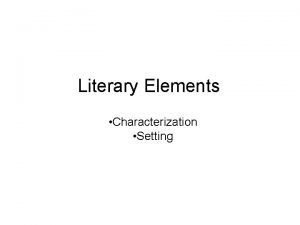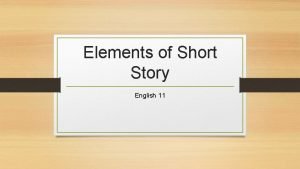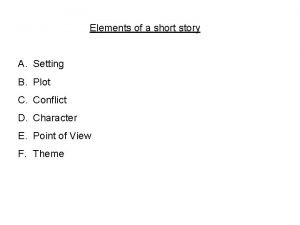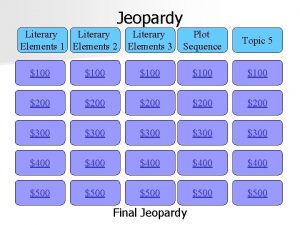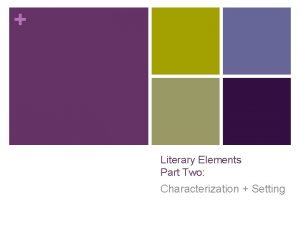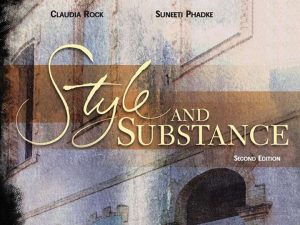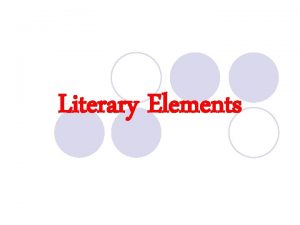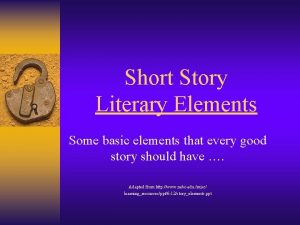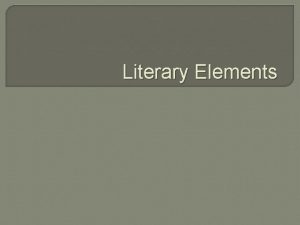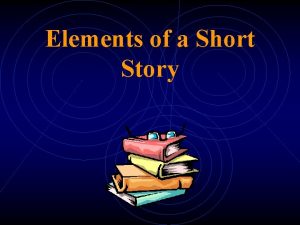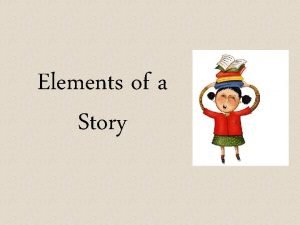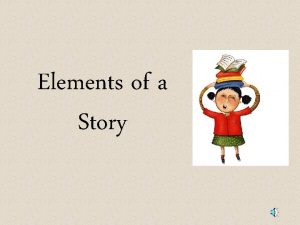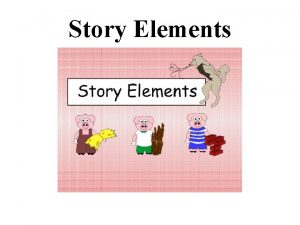Literary Elements Setting The setting of a story


































- Slides: 34

Literary Elements

Setting The setting of a story includes the time and place of the action. Some stories may have more than one setting.

Characters are the people, animals, or creatures who take part in the story’s action.

Main Characters Main characters are the most important characters because they change. The protagonist is the main character who experiences the conflict(s).

Minor Characters Minor characters are less important because they stay the same. The antagonist is the person, force, or problem against which the protagonist is struggling.

Dynamic and Static Characters A dynamic character is one who goes through a personality change due to the events in the story. A static character is one whose personality does not change throughout the story.

Dynamic or Static Robin from Batman

Static

Dynamic or Static Mandy, Ella's fairy godmother from Gail Carson Levine's Ella Enchanted

Static

Dynamic or Static Ella from Gail Carson Levine's Ella Enchanted

Dynamic

Dynamic or Static Harry Potter from J. K. Rowling's Harry Potter and the Sorcerer's Stone

Dynamic

First-Person Point of View In the first-person point of view one character tells the story. This character reveals only personal thoughts and feelings of what s/he sees. The writer uses pronouns such as "I“, "me“, “mine”, or "my". Example: I woke up this morning feeling terrific. I hopped out of bed excited to start the new day. I knew that today was the day my big surprise would come.

Second-Person Point of View With the second-person point of view the narrator tells the story using the pronoun "you". The character is someone similar to you. Example: You wake up feeling really terrific. Then you hop out of bed excited to start the new day. You know that today is the day that your big surprise will come. This is rarely used in literature.

Third-Person Point of View The third-person point of view is the most commonly used in fiction. When writing in the third-person you will use pronouns such as "he", "she", or "it". Example: Brian woke up feeling terrific. He hopped out of bed excited to start the new day. He knew that today was the day that his big surprise would come.

Group Practice Using your response cards, determine if each of the following excerpts are written in first, second, or third-point of view.

1 st, 2 nd, or 3 rd Point of View Excerpt from Woodsong by Gary Paulsen I go up to the front of the team in the darkness and drag them around, realizing we are lost. My clothes have been ripped on tree limbs and my face is bleeding from cuts, and when I look back down the side of the mountain we have just climbed I see twentyseven head lamps bobbing up the trail. Twenty -seven teams have taken our smell as the valid trail and are following us. Twenty-seven teams must be met head on in the narrow brush and passed and told to turn around.

Excerpt from Woodsong by Gary Paulsen First-Person Point of View

1 st, 2 nd, or 3 rd Point of View Excerpted from Soldier's Heart by Gary Paulsen There would be a shooting war. There were rebels who had violated the law and fired on Fort Sumter and the only thing they'd respect was steel, it was said, and he knew they were right, and the Union was right, and one other thing they said as well--if a man didn't hurry he'd miss it. The only shooting war to come in a man's life and if a man didn't step right along he'd miss the whole thing. Charley didn't figure to miss it. The only problem was that Charley wasn't rightly a man yet, at least not to the army. He was fifteen and while he worked as a man worked, in the fields all of a day and into night, and looked like a man standing tall and just a bit thin with hands so big they covered a stove lid, he didn't make a beard yet and his voice had only just dropped enough so he could talk with men.

Excerpted from Soldier's Heart by Gary Paulsen Third-Person Point of View

1 st, 2 nd, or 3 rd Point of View Excerpted from Father Water, Mother Woods by Gary Paulsen It started that simply. At the courthouse or the library there was a large bulletin board, and for a dollar you could sign the board and write down your guess to win the car-through-the-ice raffle. Of course, you never met anyone who had won, but only those who knew somebody who had won, and therein, in the winning, the simplicity was lost.

Excerpted from Father Water, Mother Woods by Gary Paulsen Second-Person Point of View

While walking home, he tripped and fell into a puddle of water. 1 st, 2 nd, or 3 rd Point of View ? I believe that it’s important for students to be involved in after school activities. 1 st, 2 nd, or 3 rd Point of View ?

Several of their players have signed scholarships to play college football. 1 st, 2 nd, or 3 rd Point of View ? You should know better than to send a text message while driving! 1 st, 2 nd, or 3 rd Point of View ?

Softball is my favorite sport, but soccer is a close second. 1 st, 2 nd, or 3 rd Point of View ? Darrell went to the movies with John this weekend. 1 st, 2 nd, or 3 rd Point of View ?

Conflict is the problem or struggle that a character faces in the story. In short stories, there is usually one major conflict. In longer stories, there could be several conflicts. CONFLICT STATEMENT: “Protagonist wants ______ but …”

Conflict Some forms of conflict include the following: • Person vs. Person • Person vs. Self • Person vs. Nature • Person vs. Society

Person vs. Person An EXTERNAL conflict that involves a struggle, mental or physical, between two characters in the story. Examples From Where the Red Fern Grows - Billy and his dogs are attacked by a mountain lion, and they must do everything they can to survive.

Person vs. Self An INTERNAL conflict that involves the struggle between the character and his/her conscience. Examples From The Good Deed by Marion Bauer Heather couldn’t stand being bested by a girl who still read a little kiddy book with her lips…

Person vs. the Nature Person vs. Nature An EXTERNAL conflict that involves a struggle between the character and the elements of nature that are beyond his/her control. Example: From Where the Red Fern Grows - Billy enters the championship coon hunt and encounters the snowstorm. From The Wizard of Oz Dorothy encounters a tornado and has to find a way back home.

Person vs. Society An EXTERNAL conflict that involves the struggle between a character and the rules or laws that govern the society in which he/she lives. Example The Island of the Skog by Steven Kellogg “I’m tired of living in a hole, ” said Jenny. “Let’s fight for freedom!” cried Bouncer. “We’ll be soldiers! Rough-riding Rowdies! I’ll be the general and commander-inchief!”

Theme is the central message or life lesson that the writer wants readers to understand. Ask yourself this question. What should you learn from the story?
 What are the poetic devices
What are the poetic devices Literacy elements
Literacy elements Characterized
Characterized Literary elements of fiction
Literary elements of fiction Five elements of a short story
Five elements of a short story Settings of short story
Settings of short story Narrative element
Narrative element Hình ảnh bộ gõ cơ thể búng tay
Hình ảnh bộ gõ cơ thể búng tay Slidetodoc
Slidetodoc Bổ thể
Bổ thể Tỉ lệ cơ thể trẻ em
Tỉ lệ cơ thể trẻ em Gấu đi như thế nào
Gấu đi như thế nào Chụp tư thế worms-breton
Chụp tư thế worms-breton Chúa yêu trần thế
Chúa yêu trần thế Các môn thể thao bắt đầu bằng từ đua
Các môn thể thao bắt đầu bằng từ đua Thế nào là hệ số cao nhất
Thế nào là hệ số cao nhất Các châu lục và đại dương trên thế giới
Các châu lục và đại dương trên thế giới Công của trọng lực
Công của trọng lực Trời xanh đây là của chúng ta thể thơ
Trời xanh đây là của chúng ta thể thơ Cách giải mật thư tọa độ
Cách giải mật thư tọa độ 101012 bằng
101012 bằng Phản ứng thế ankan
Phản ứng thế ankan Các châu lục và đại dương trên thế giới
Các châu lục và đại dương trên thế giới Thể thơ truyền thống
Thể thơ truyền thống Quá trình desamine hóa có thể tạo ra
Quá trình desamine hóa có thể tạo ra Một số thể thơ truyền thống
Một số thể thơ truyền thống Cái miệng nó xinh thế
Cái miệng nó xinh thế Vẽ hình chiếu vuông góc của vật thể sau
Vẽ hình chiếu vuông góc của vật thể sau Nguyên nhân của sự mỏi cơ sinh 8
Nguyên nhân của sự mỏi cơ sinh 8 đặc điểm cơ thể của người tối cổ
đặc điểm cơ thể của người tối cổ V. c c
V. c c Vẽ hình chiếu đứng bằng cạnh của vật thể
Vẽ hình chiếu đứng bằng cạnh của vật thể Tia chieu sa te
Tia chieu sa te Thẻ vin
Thẻ vin đại từ thay thế
đại từ thay thế


